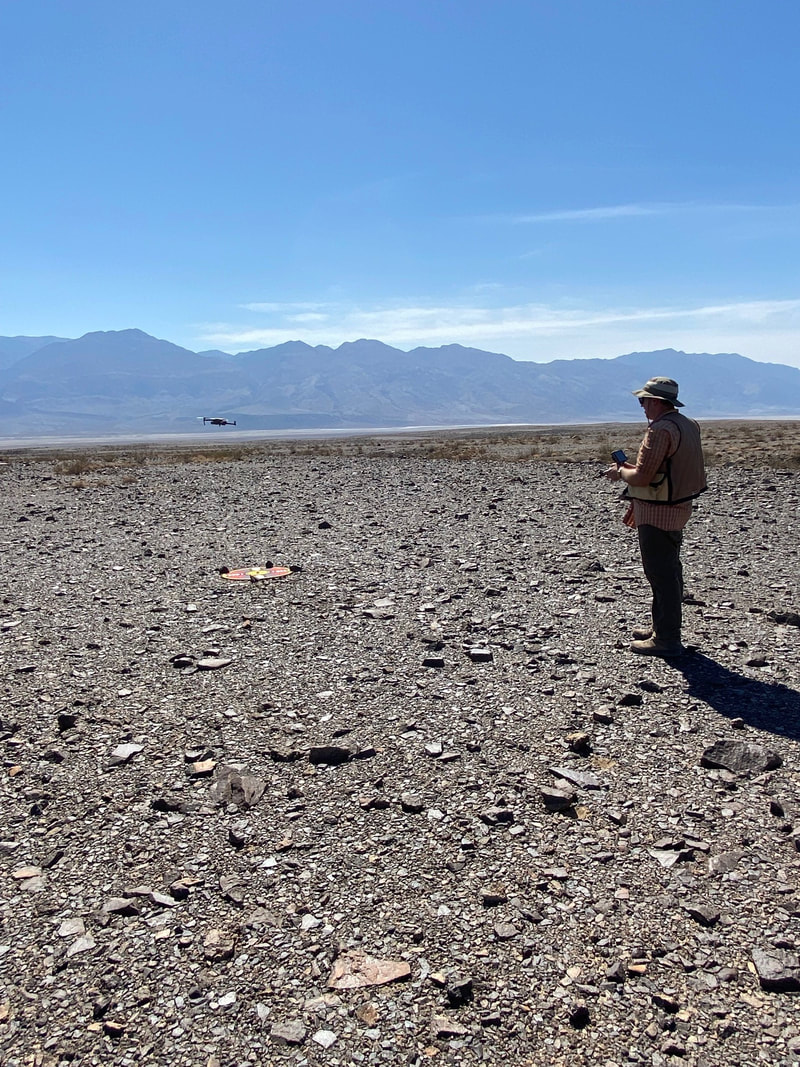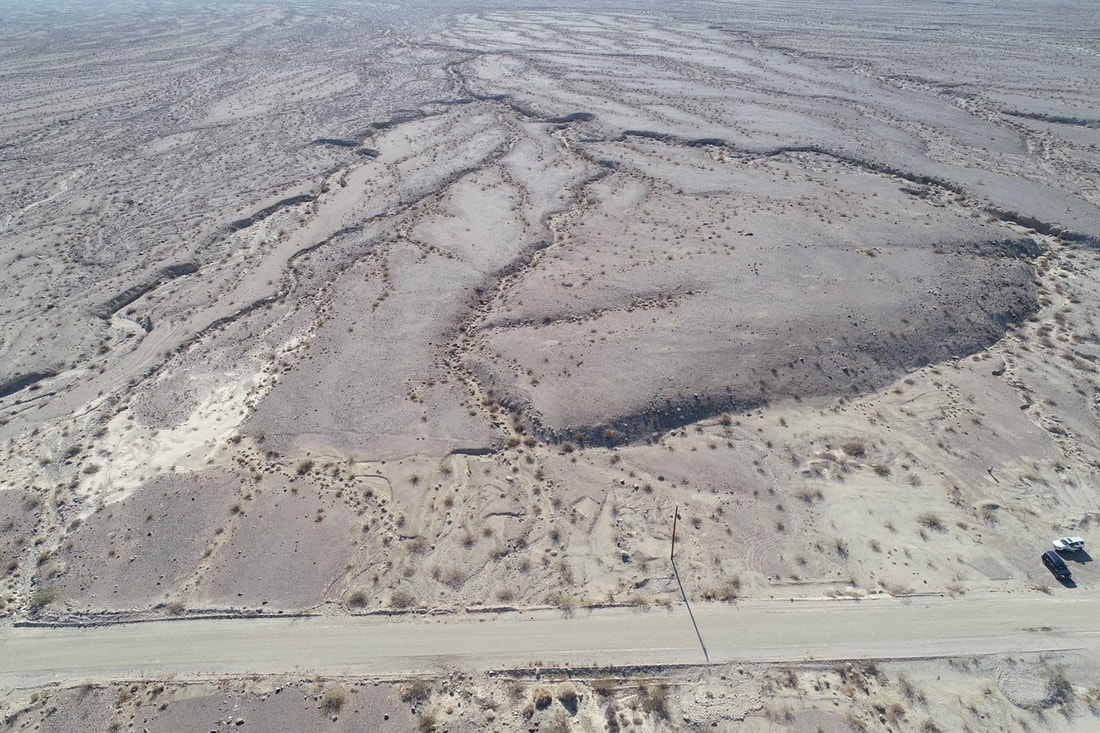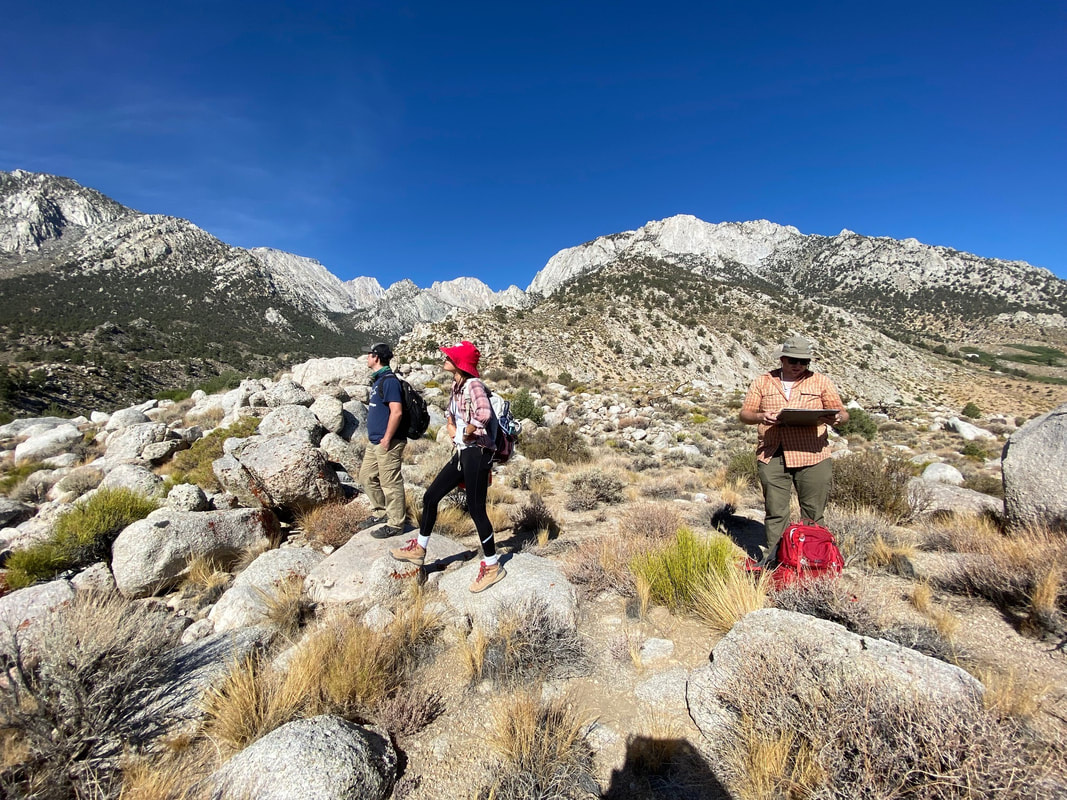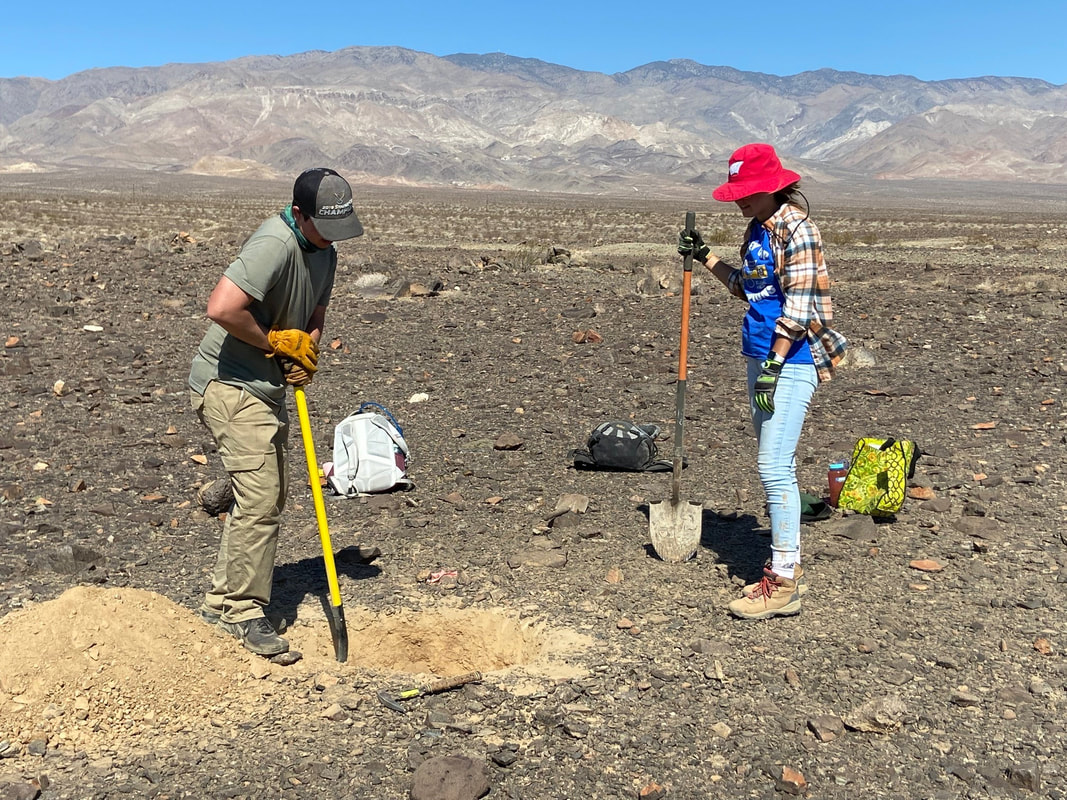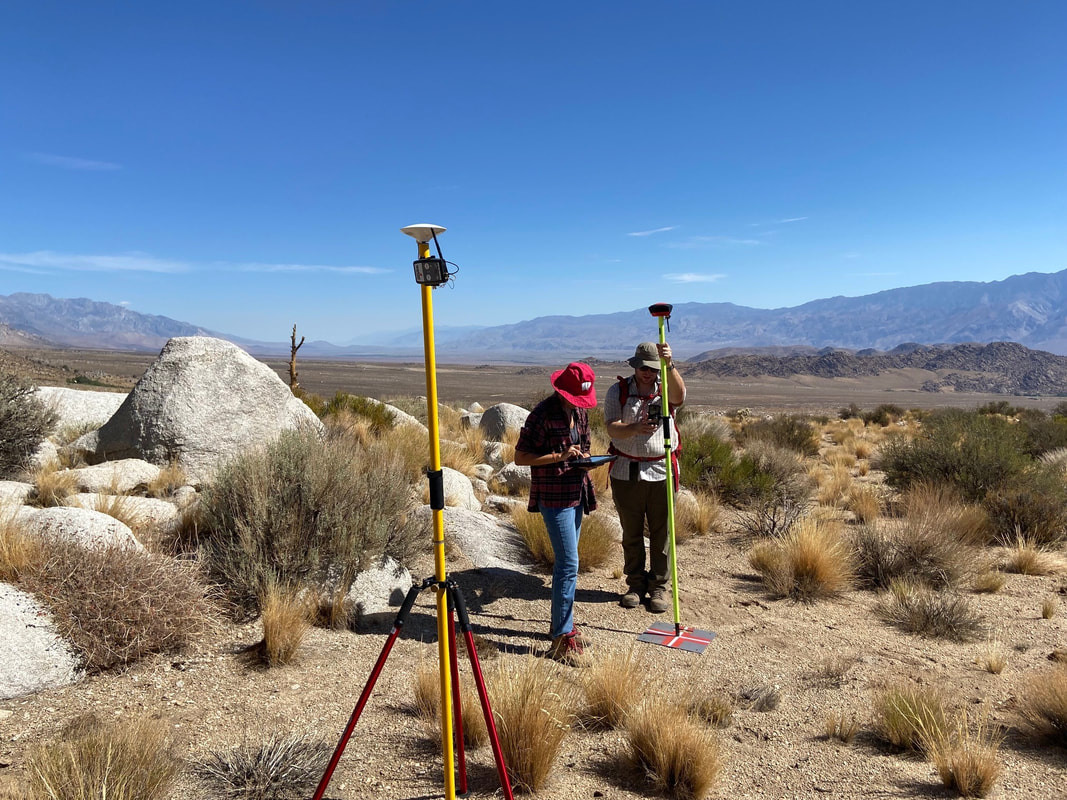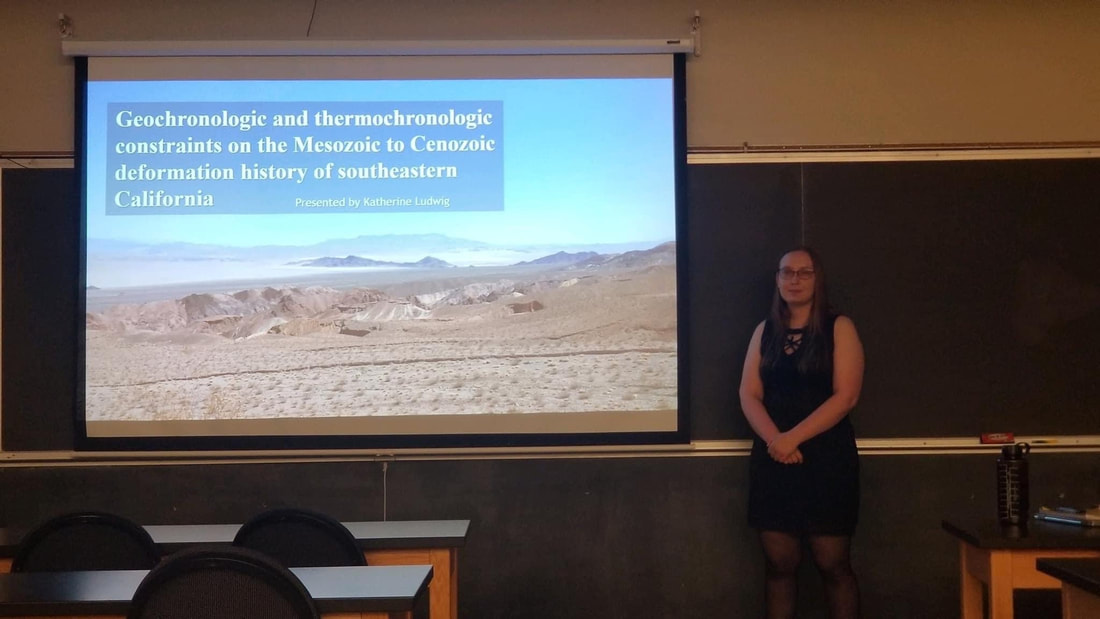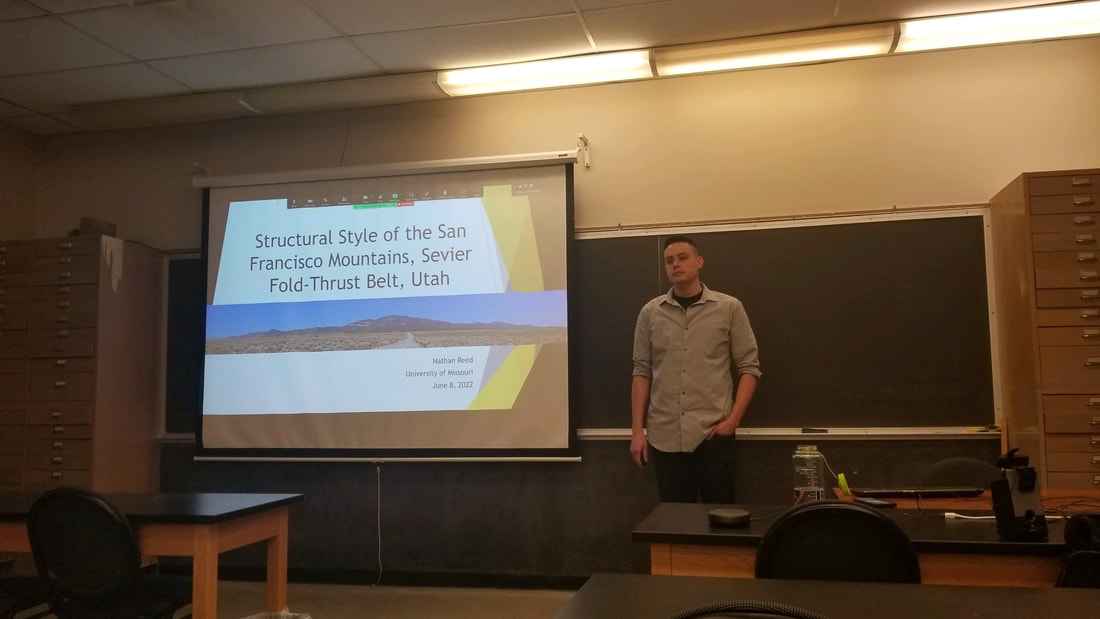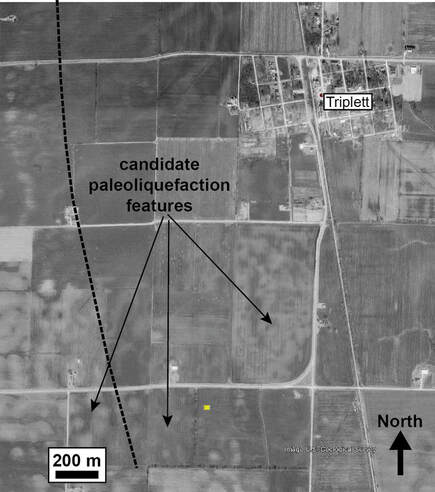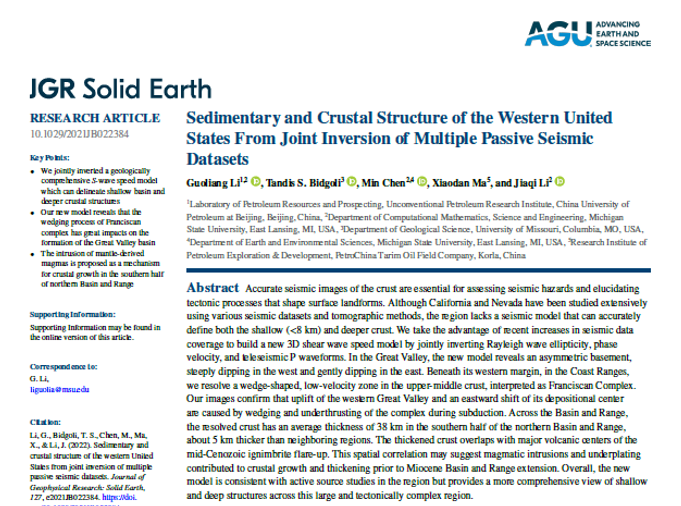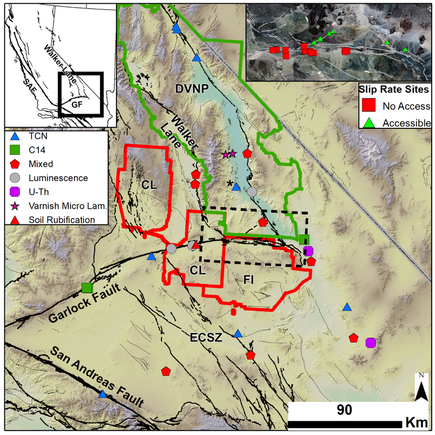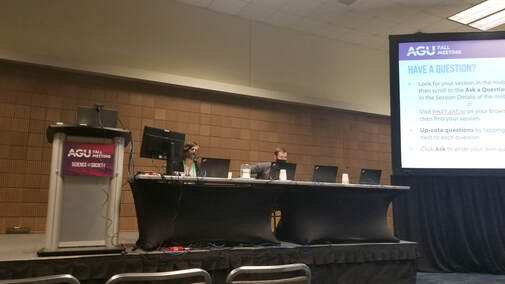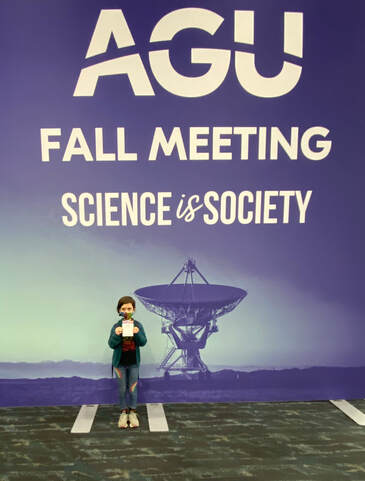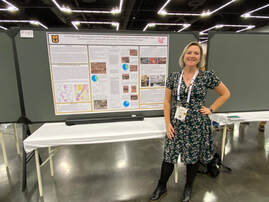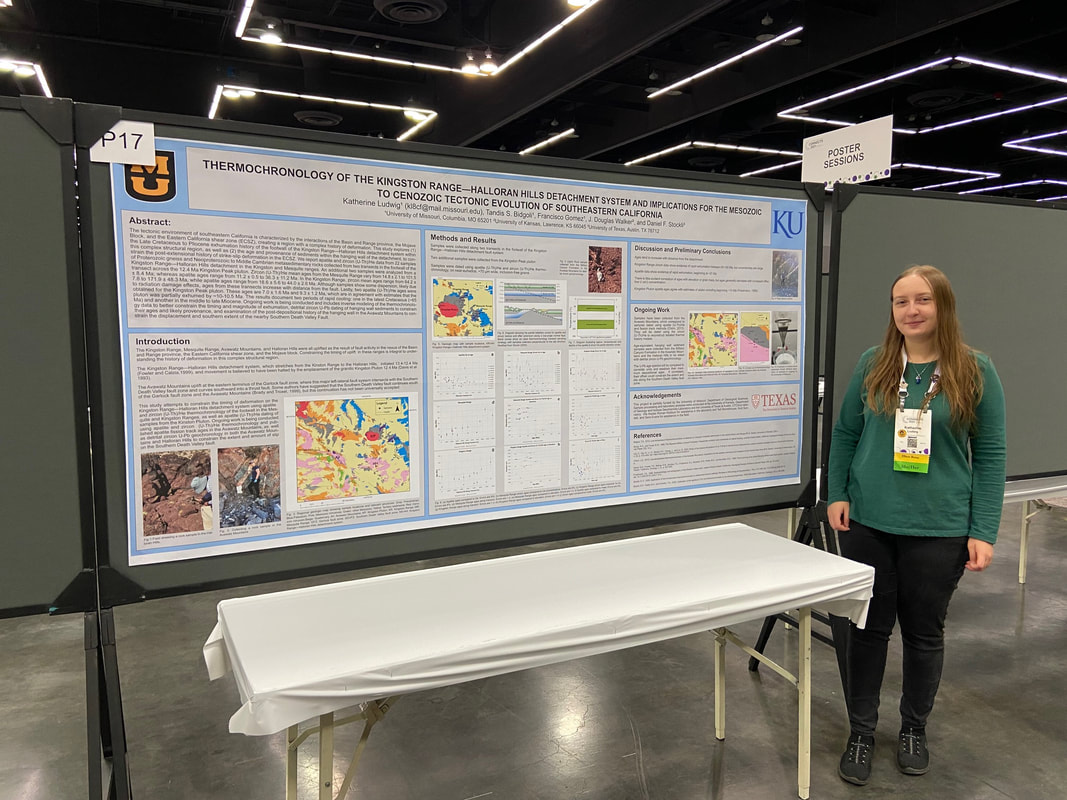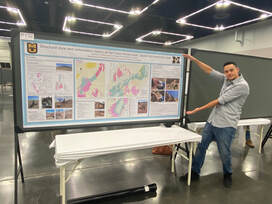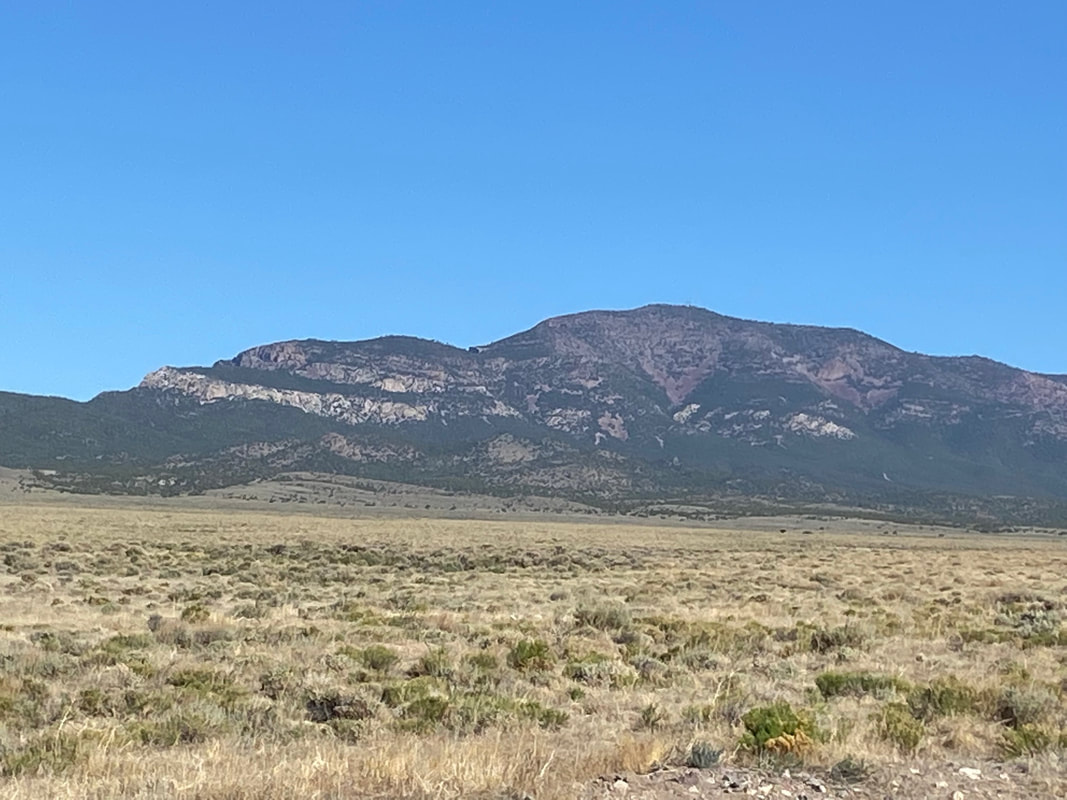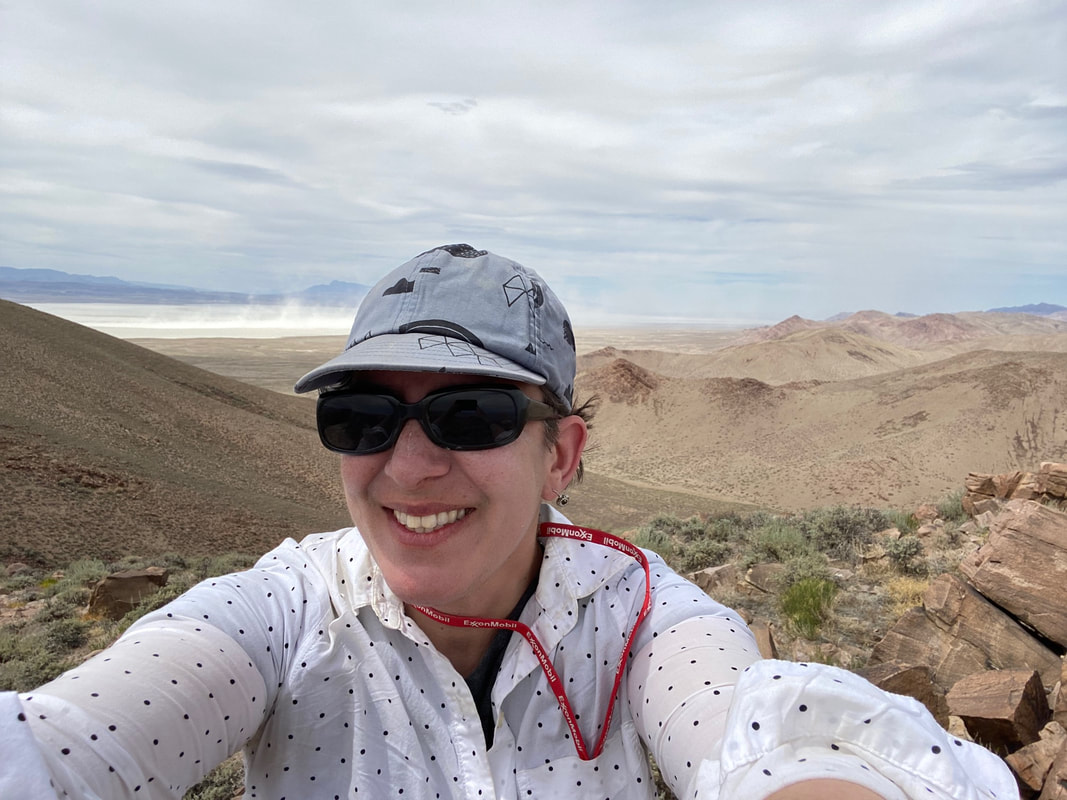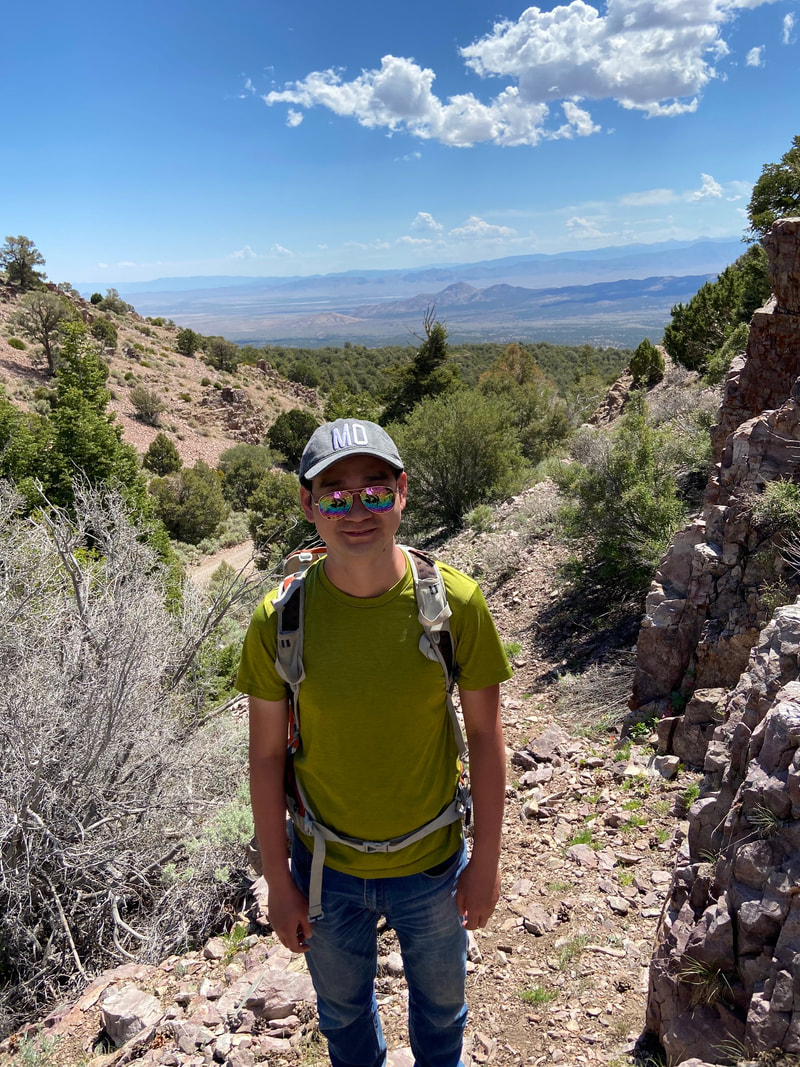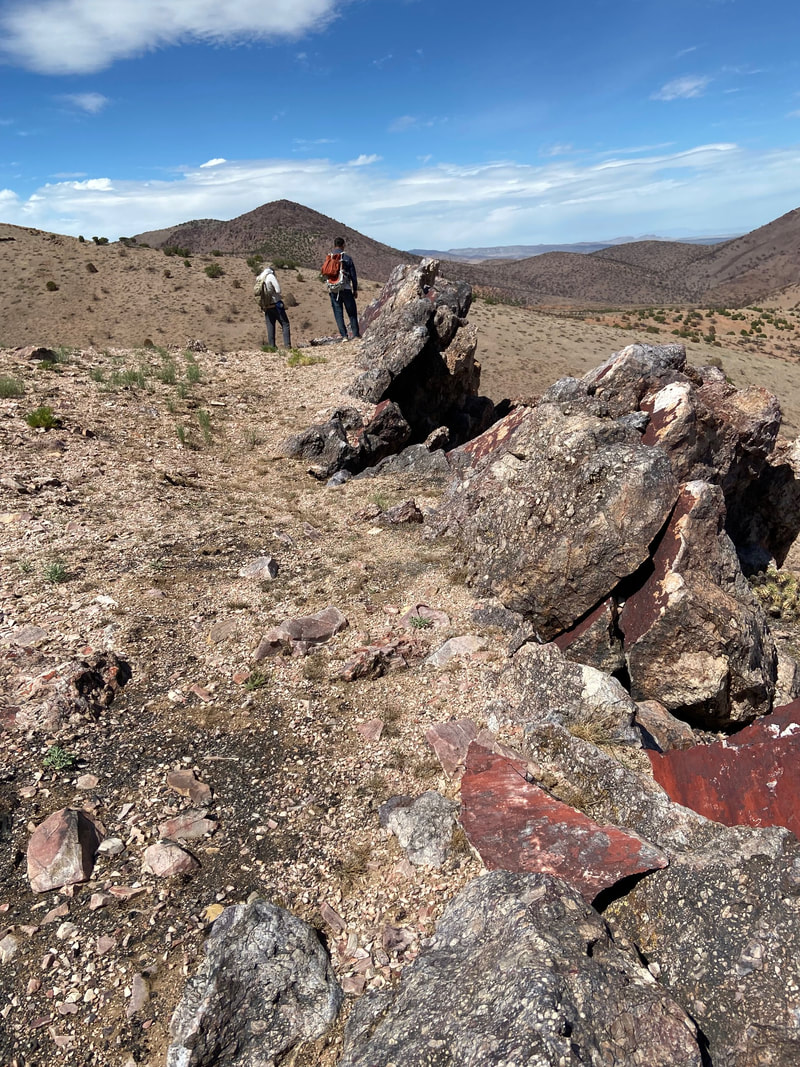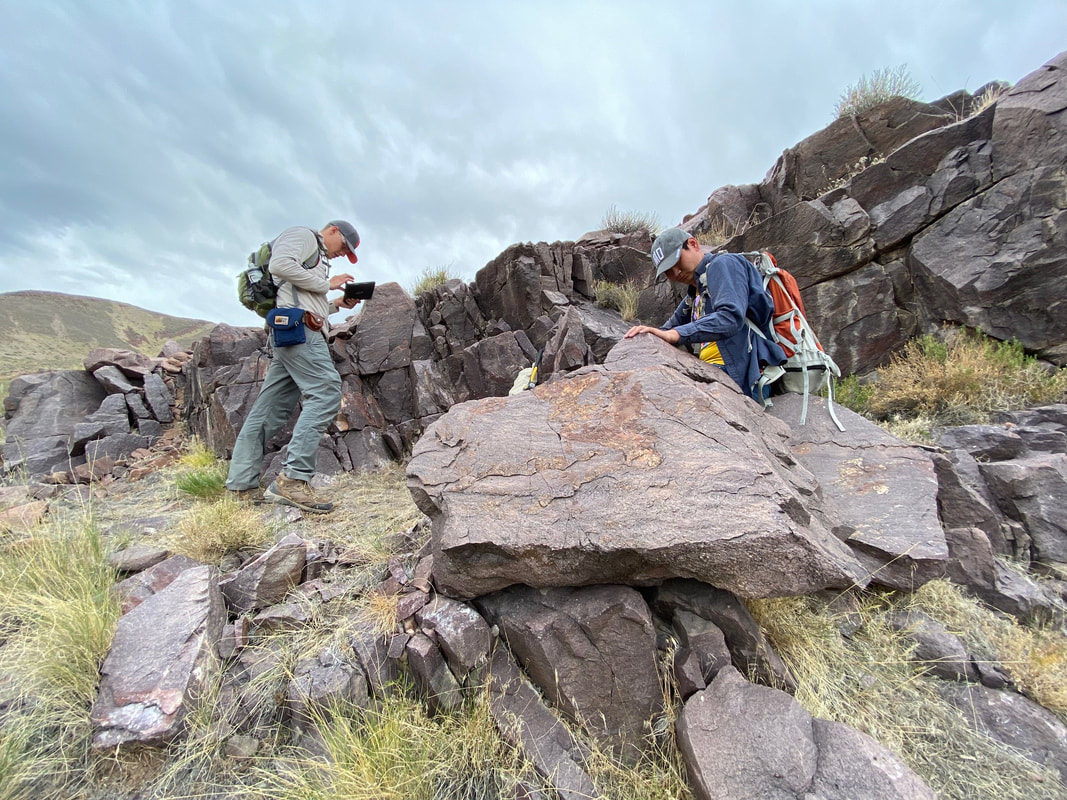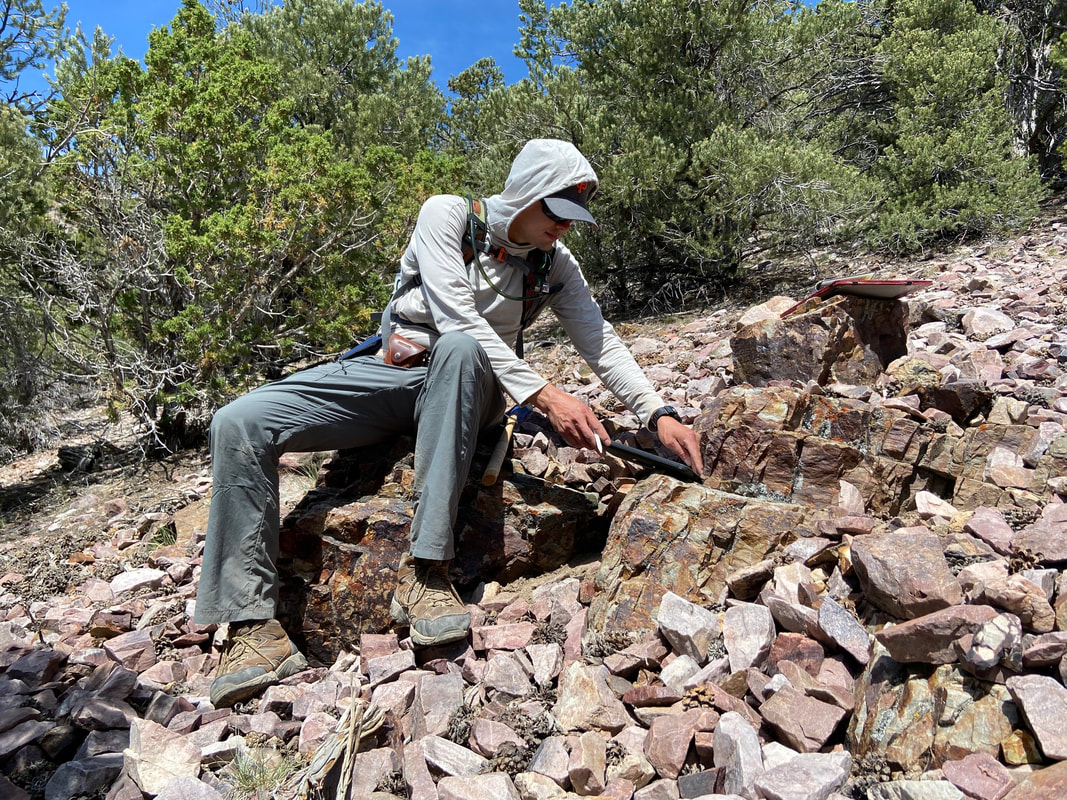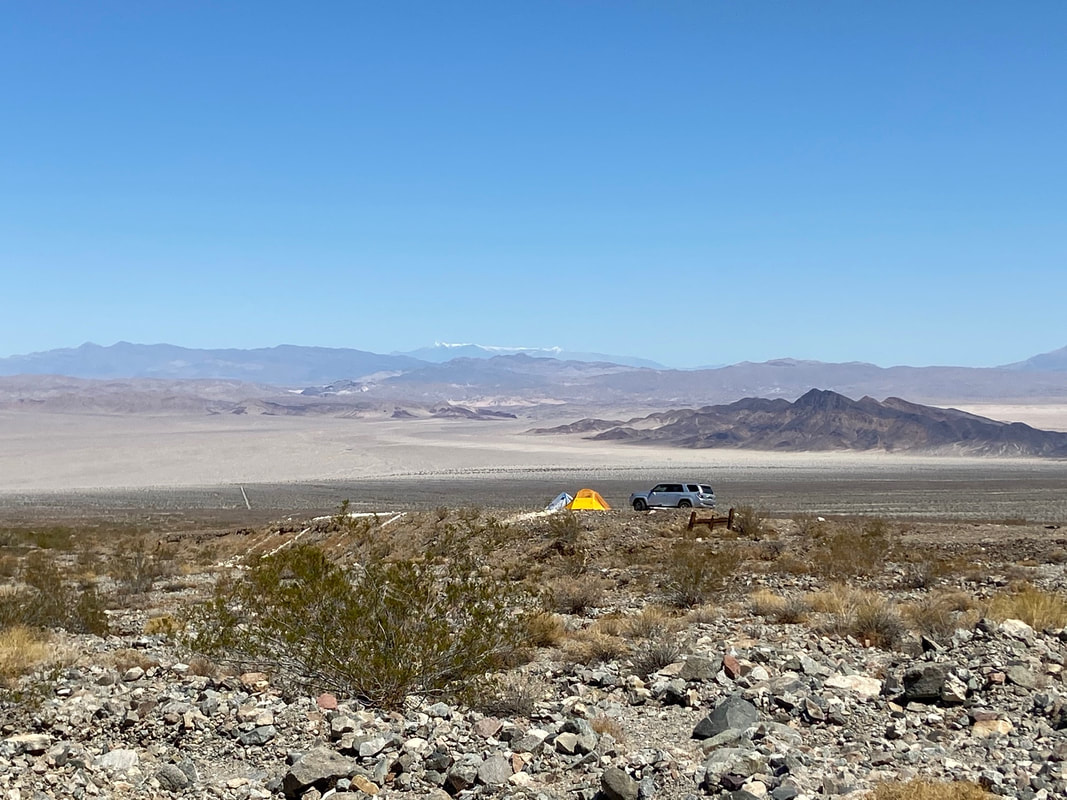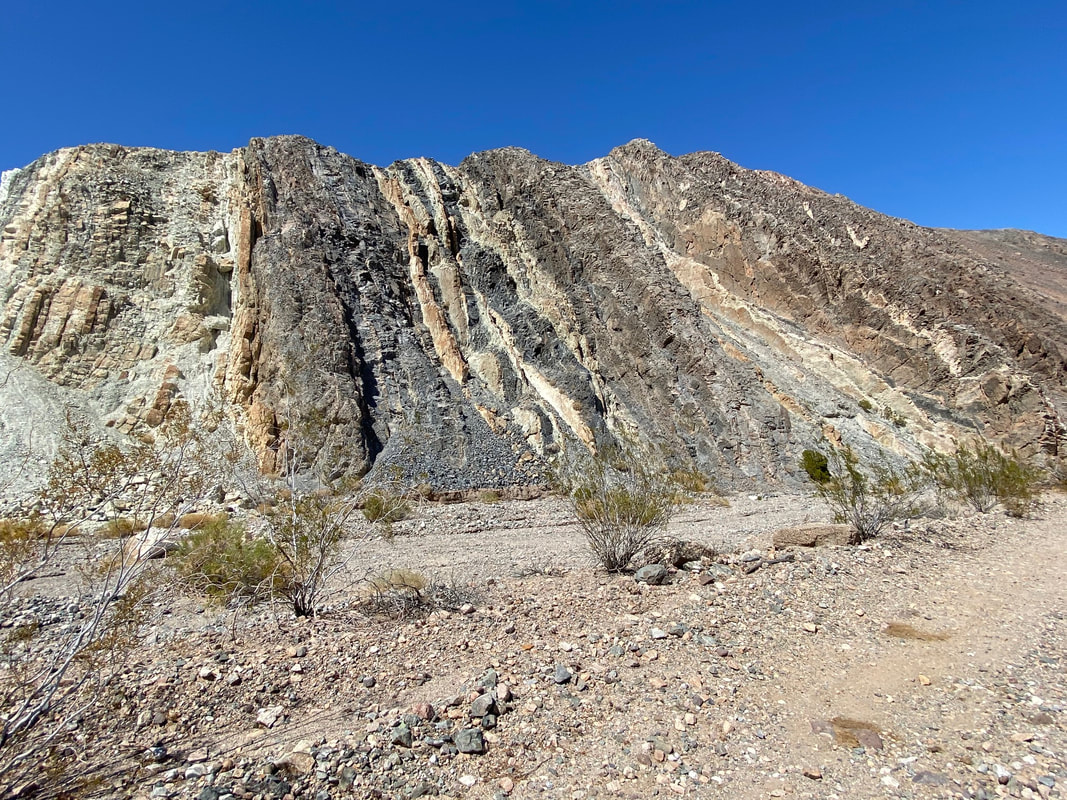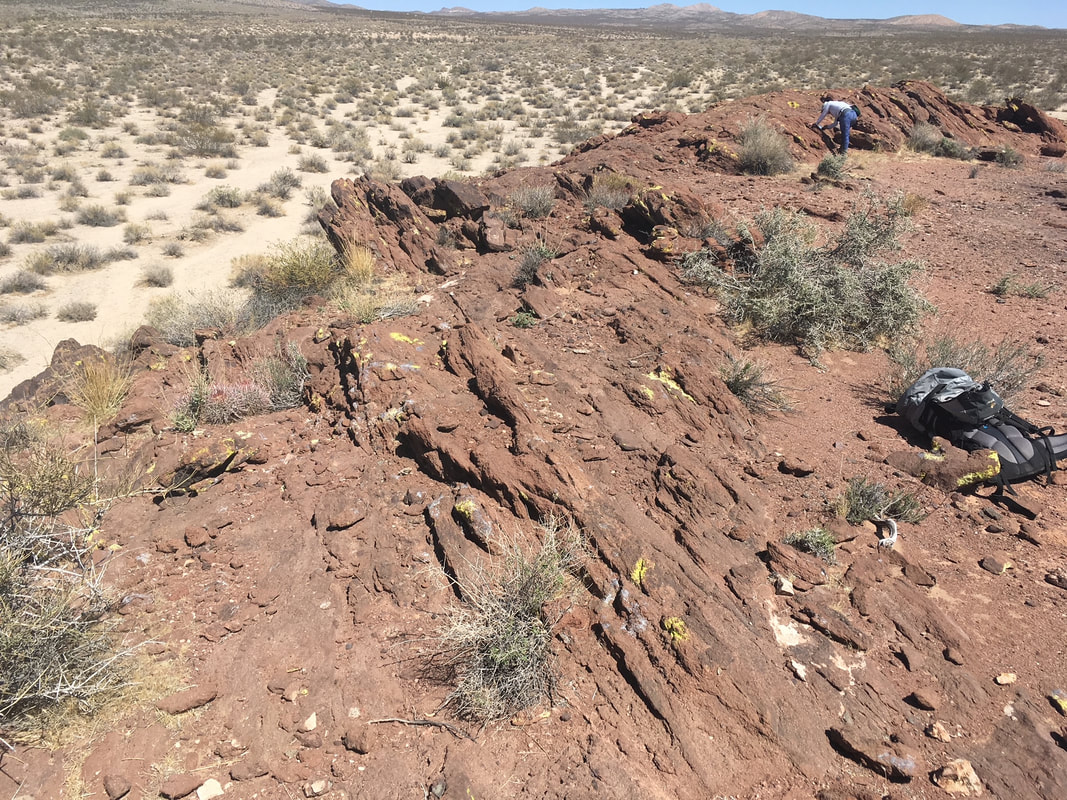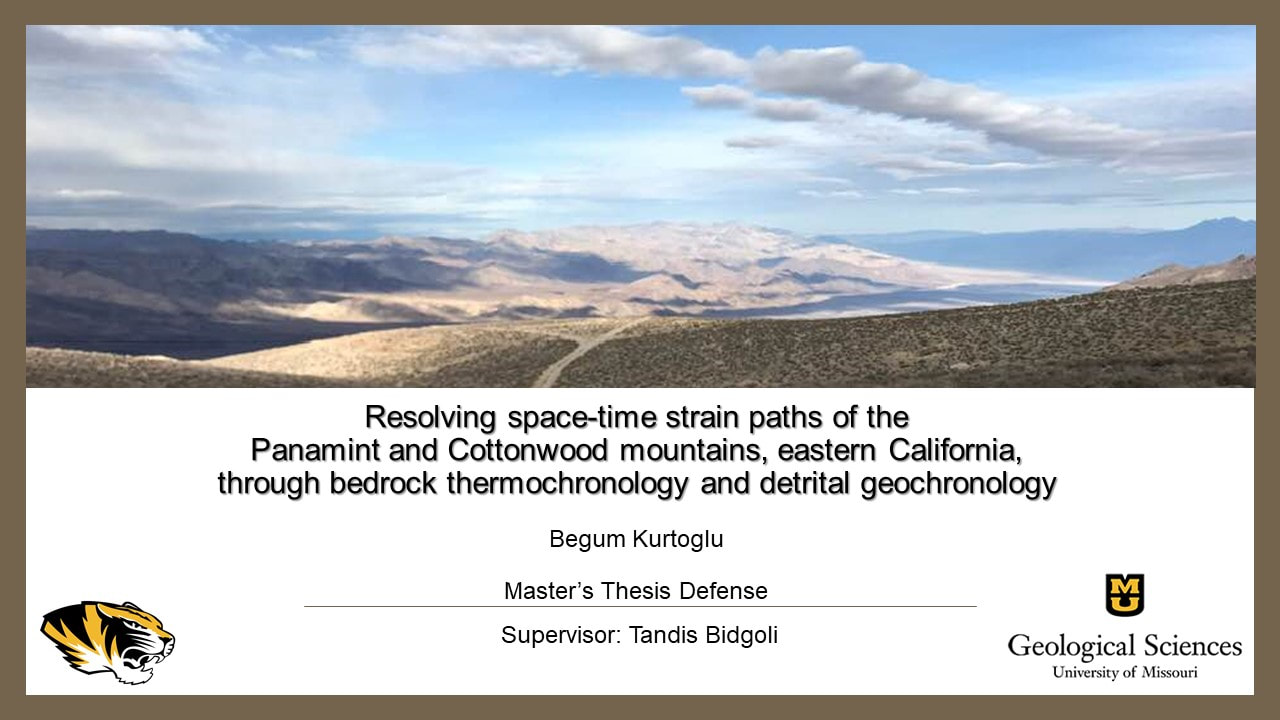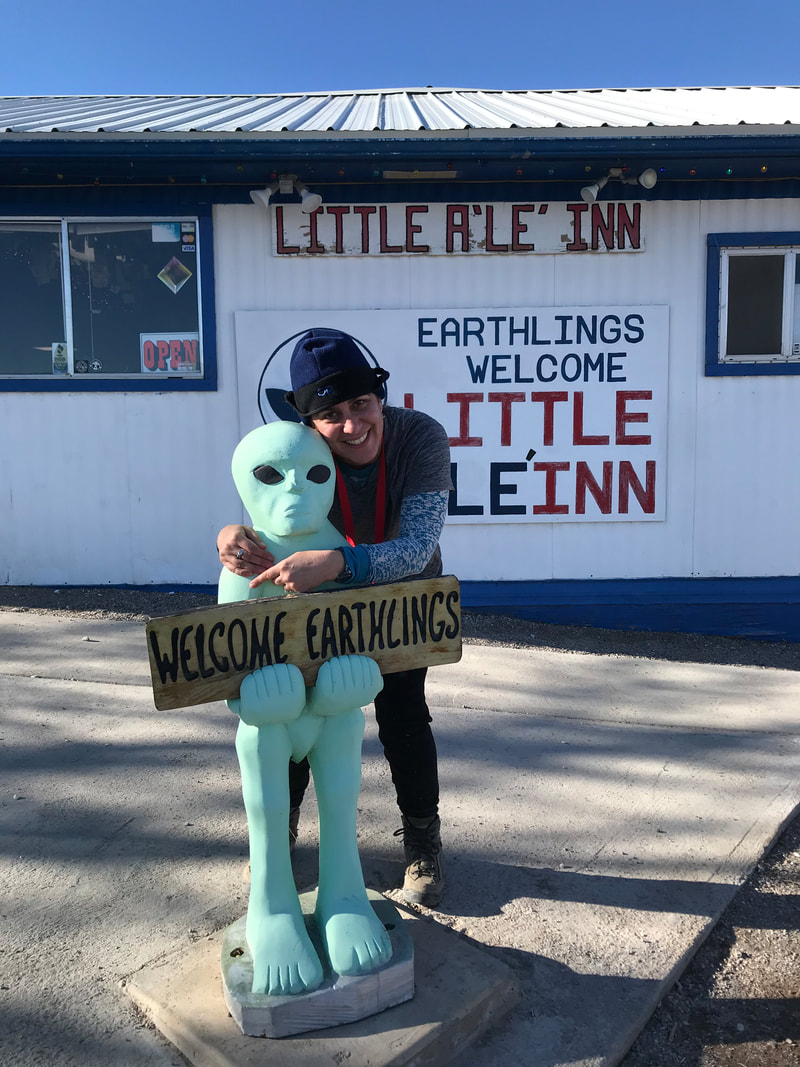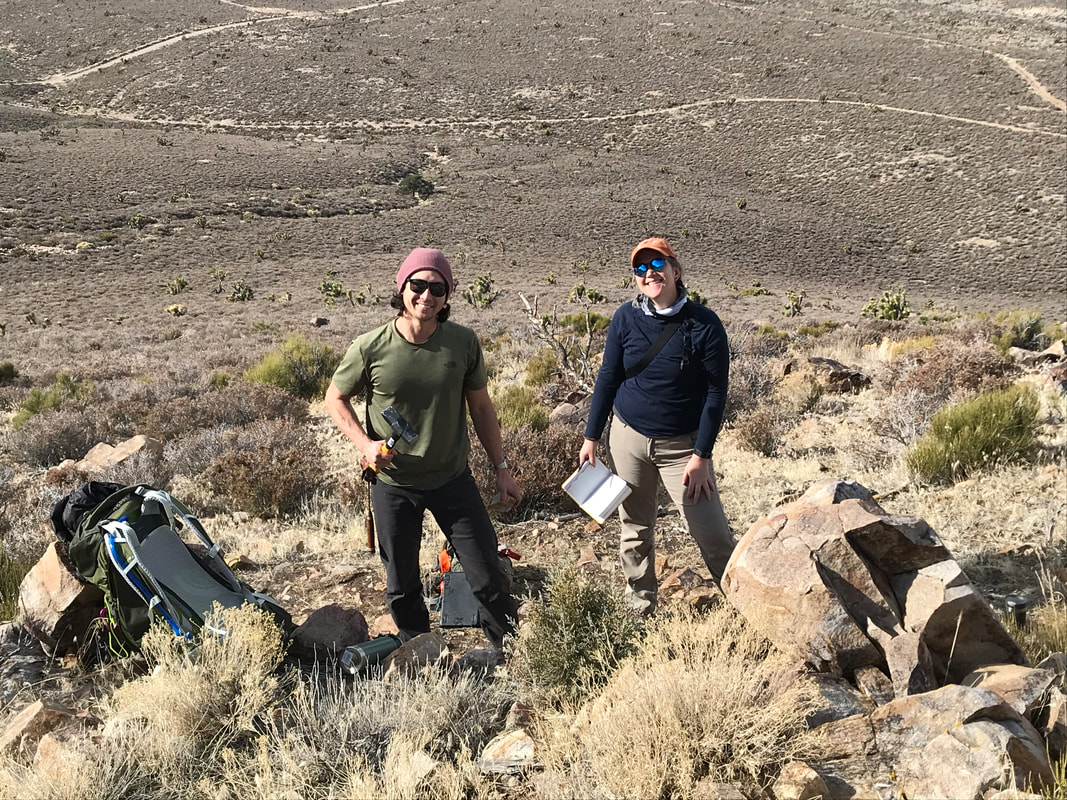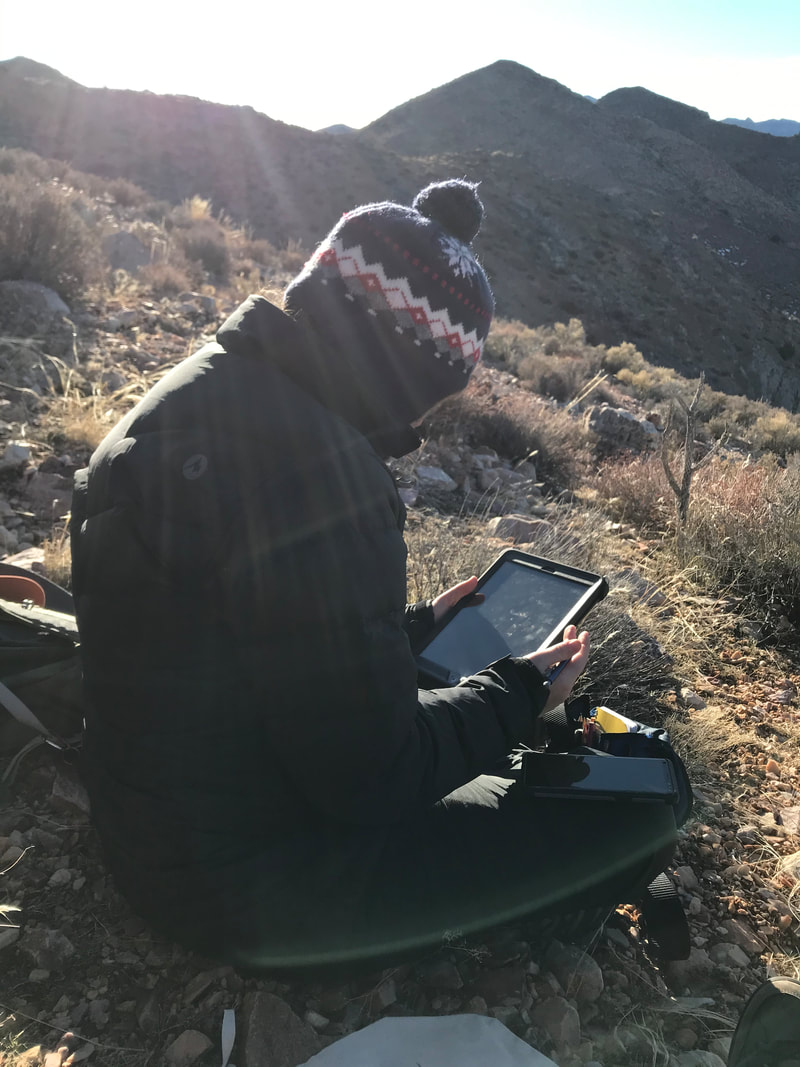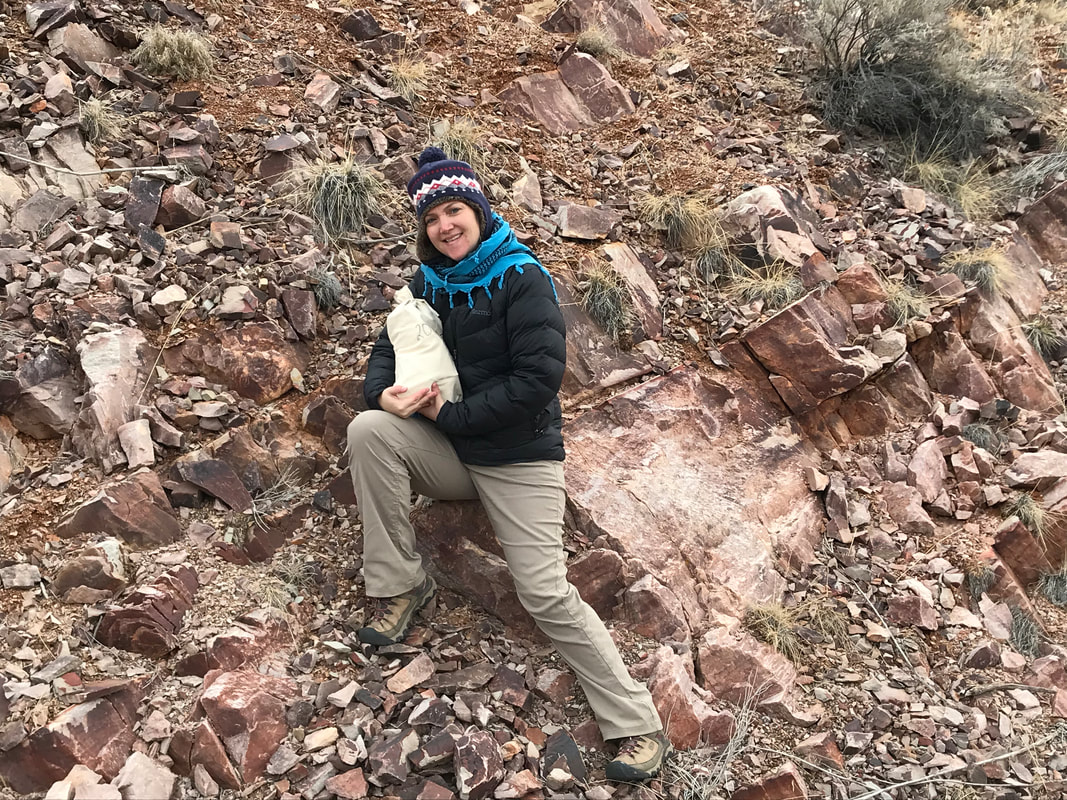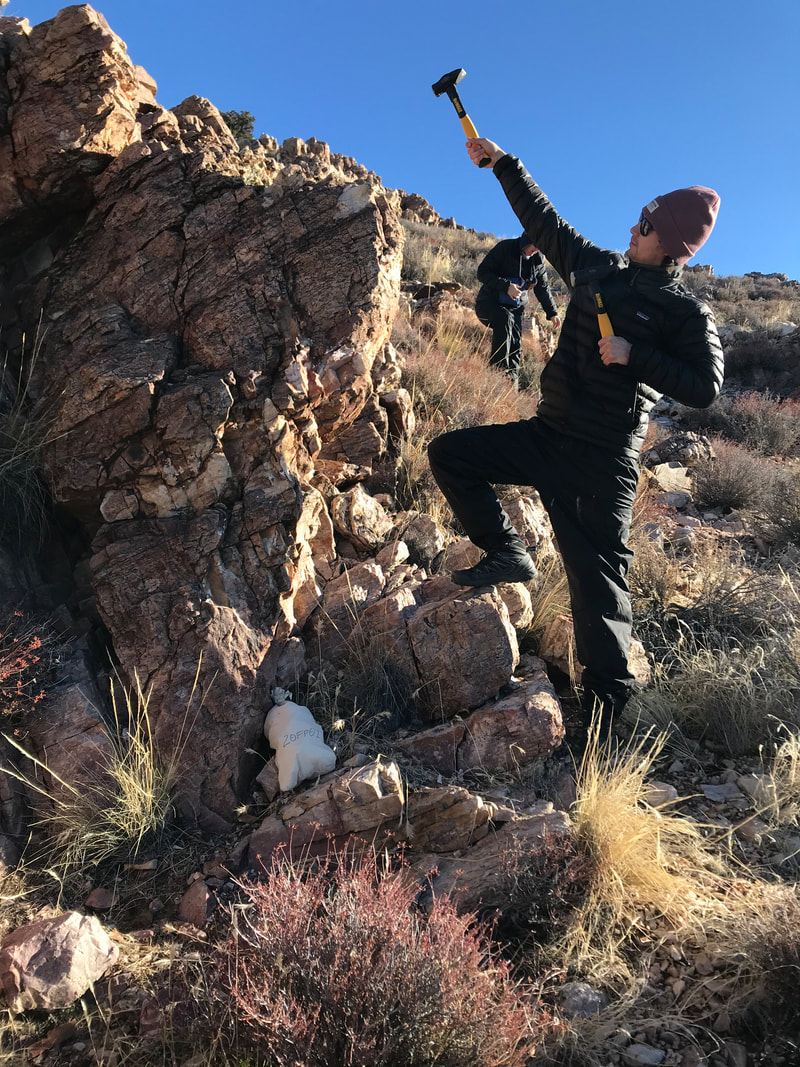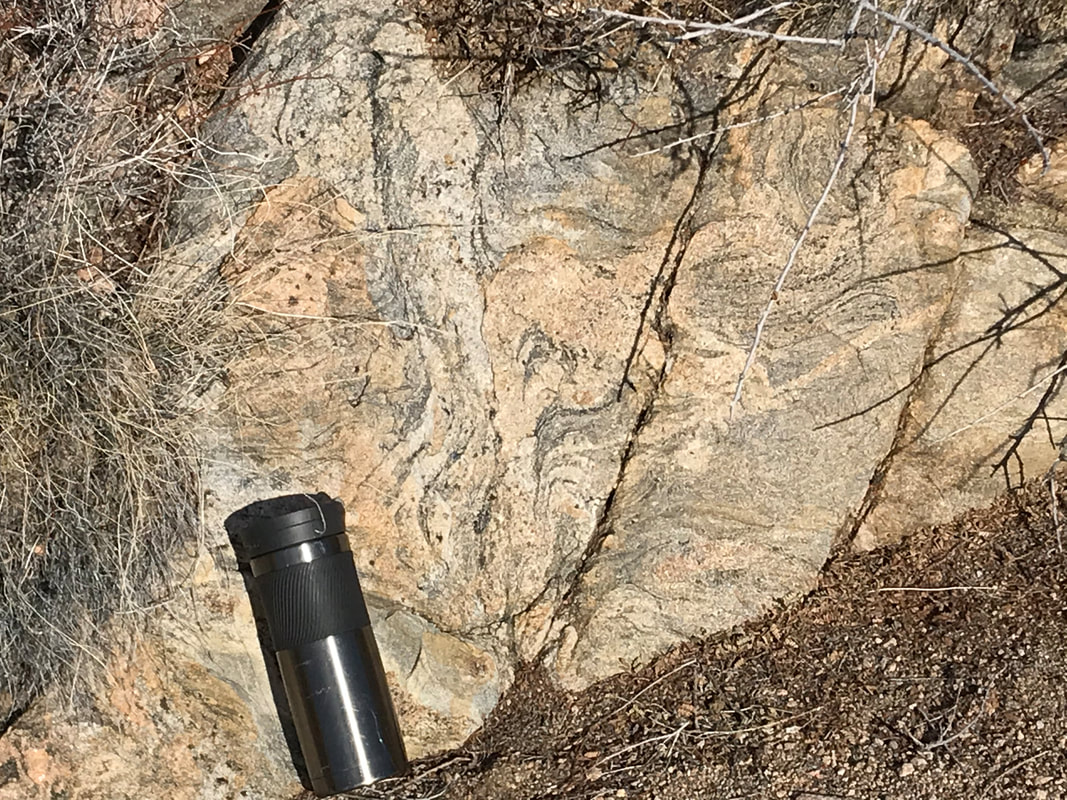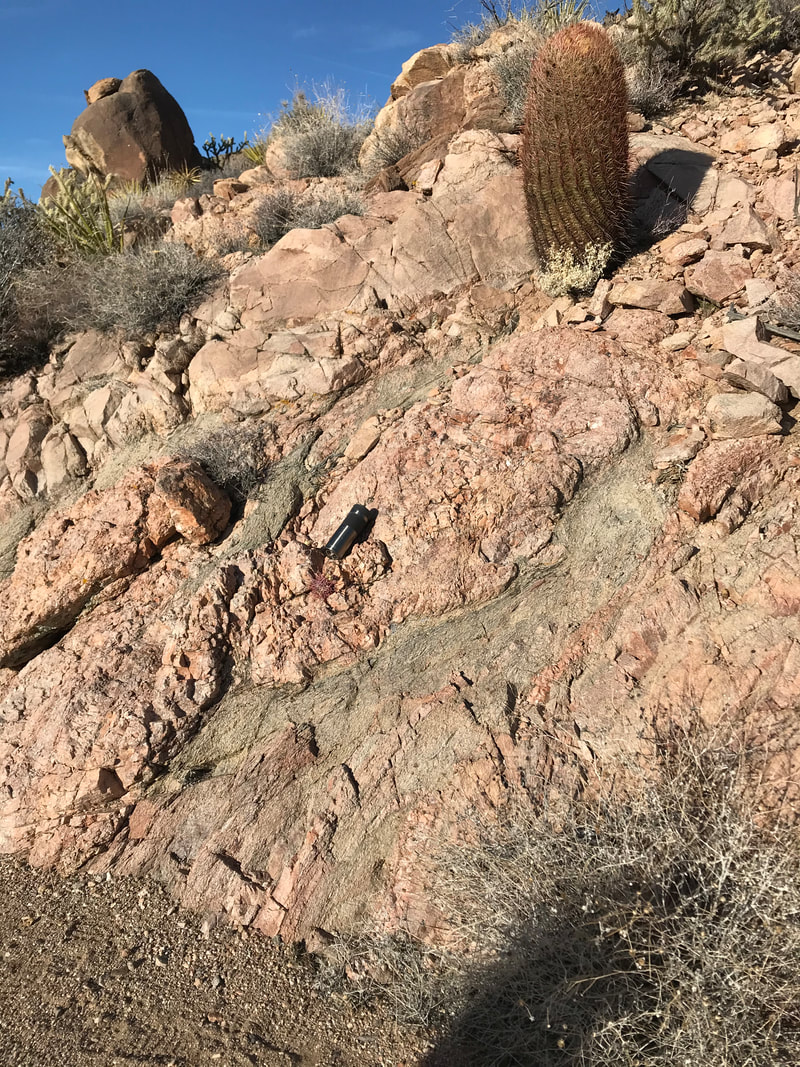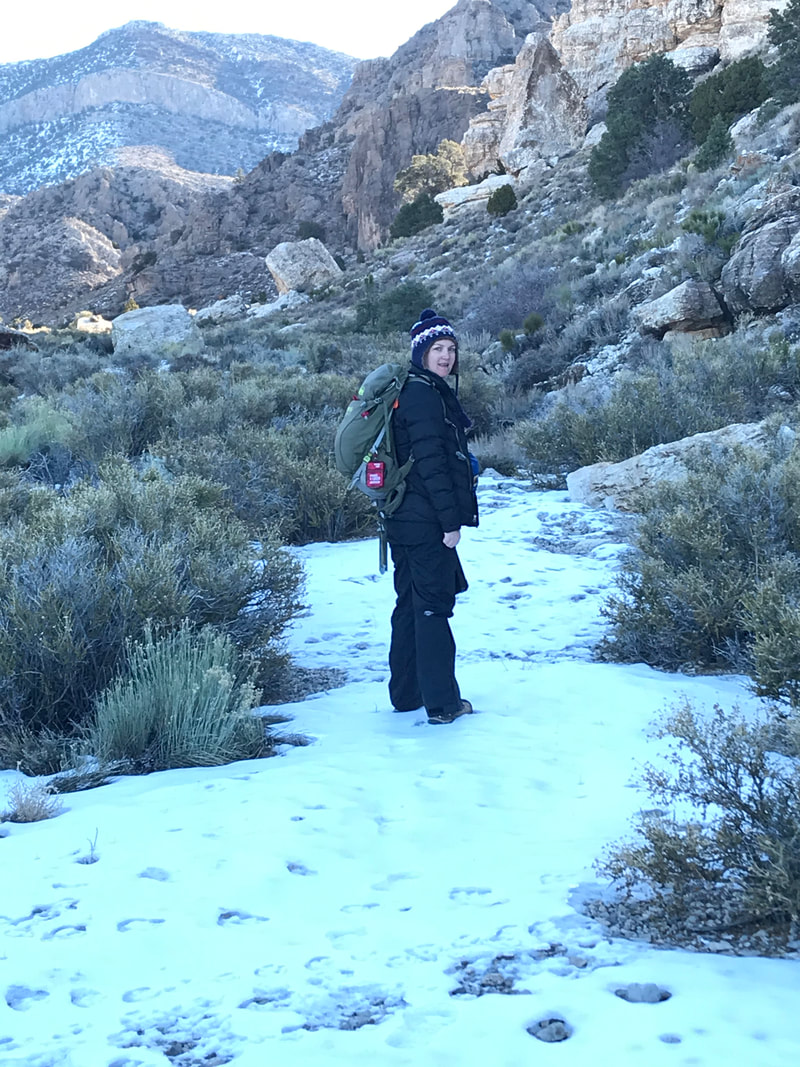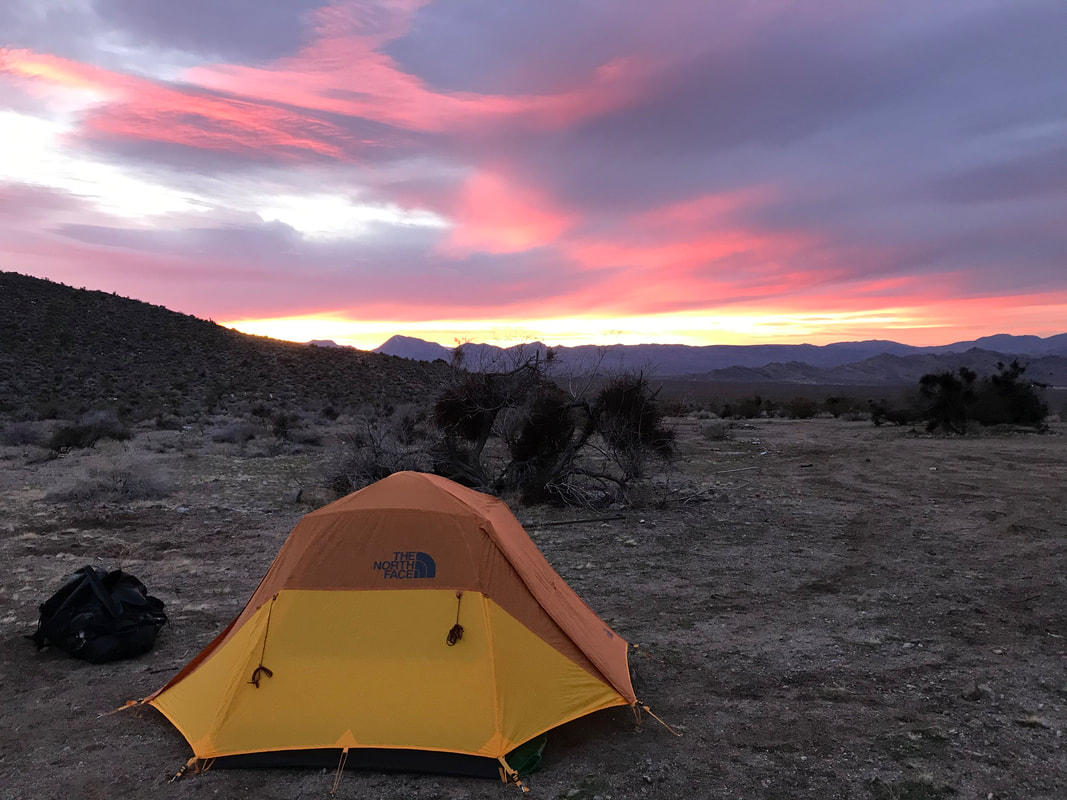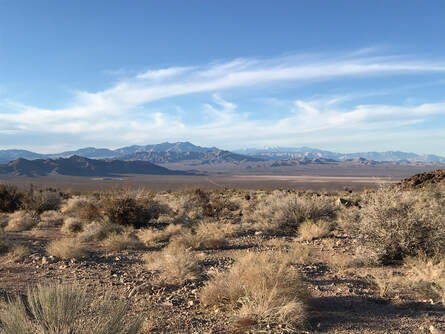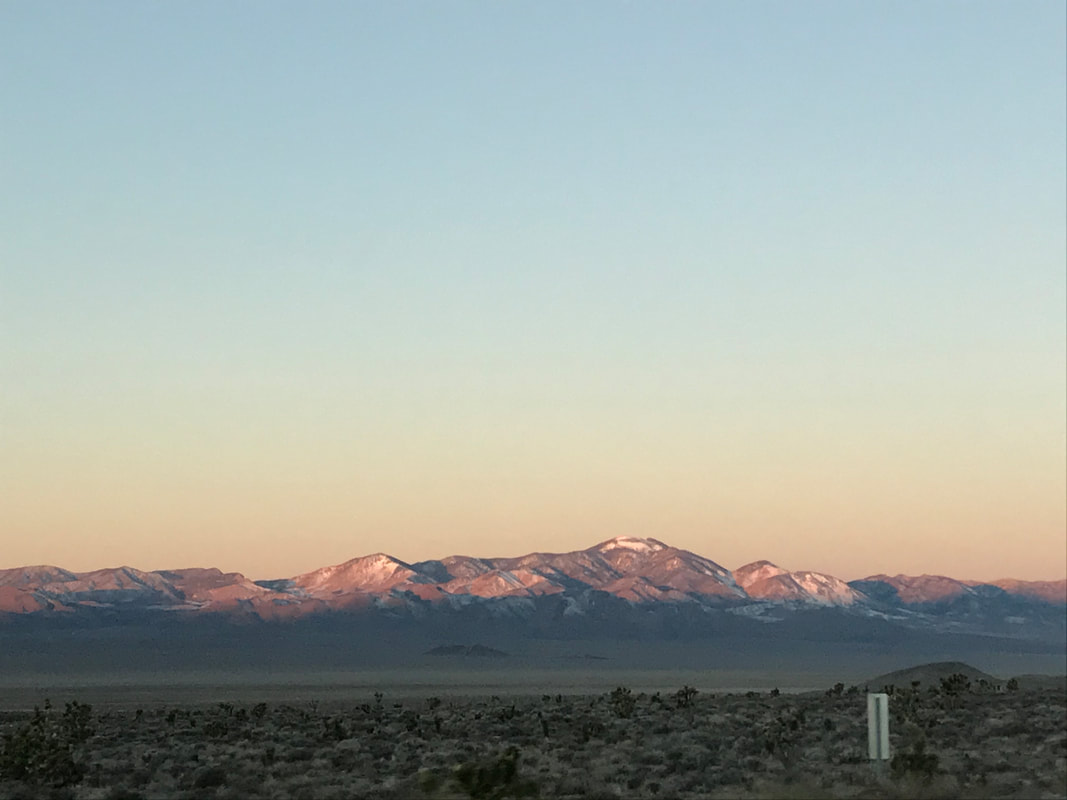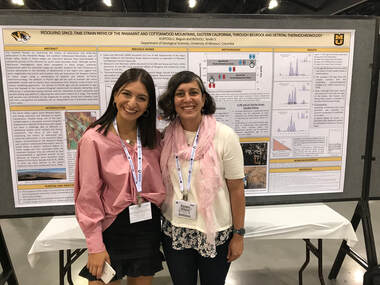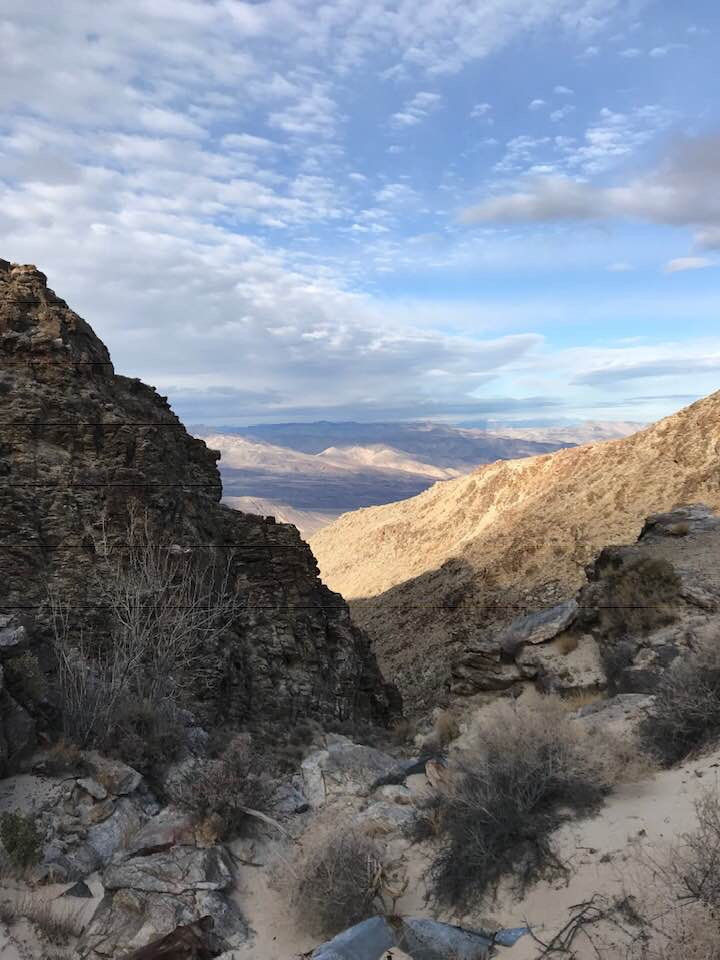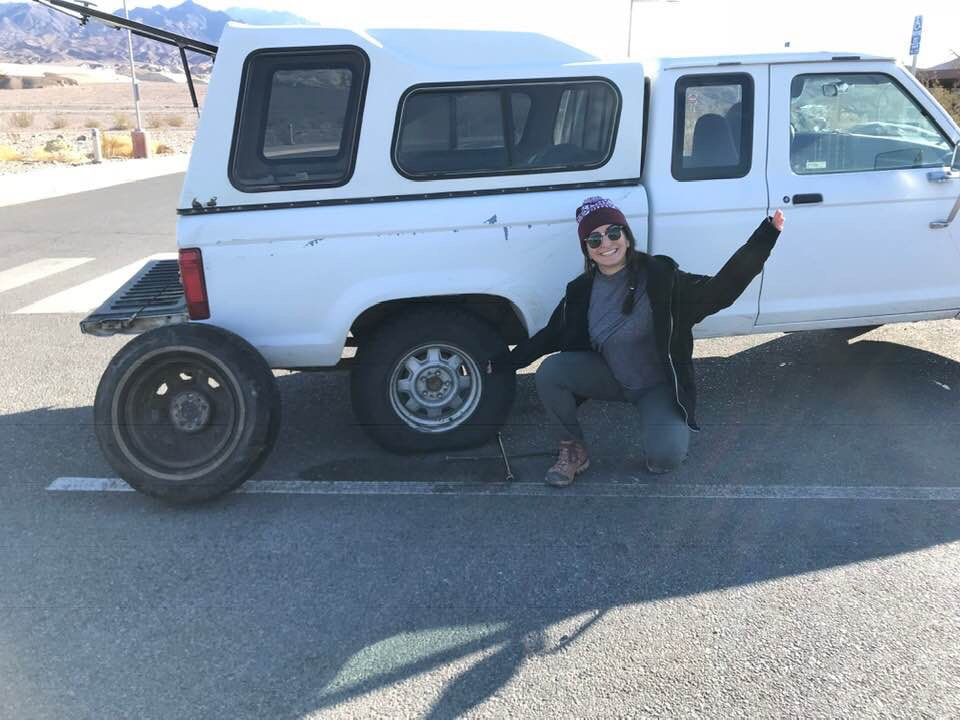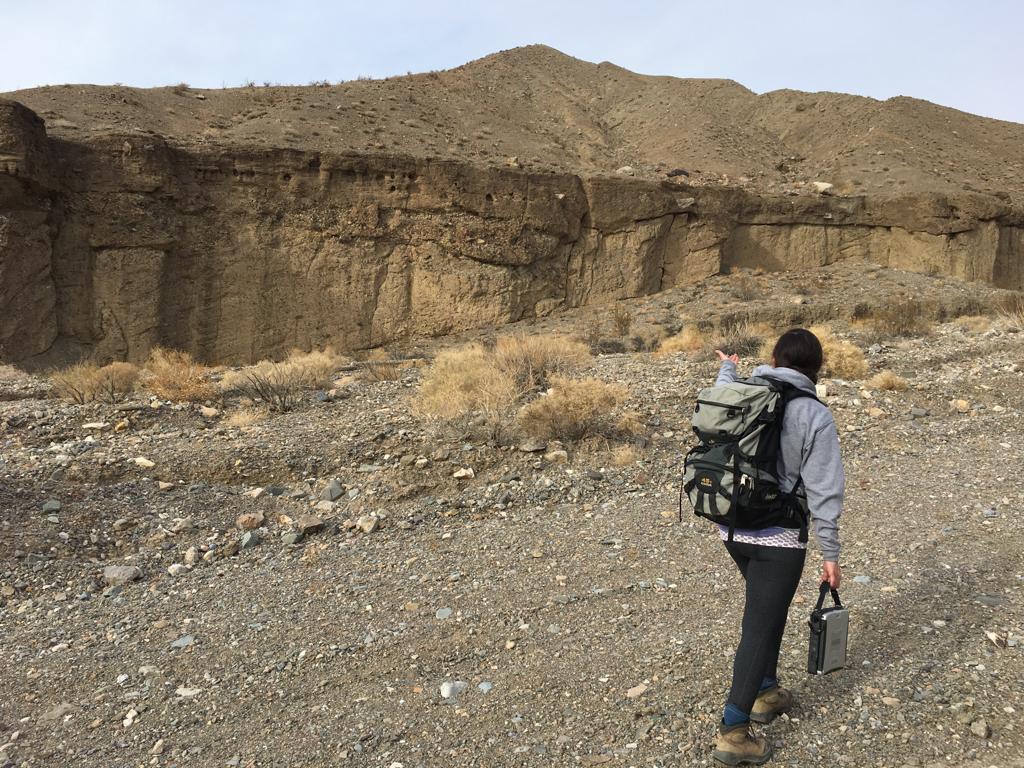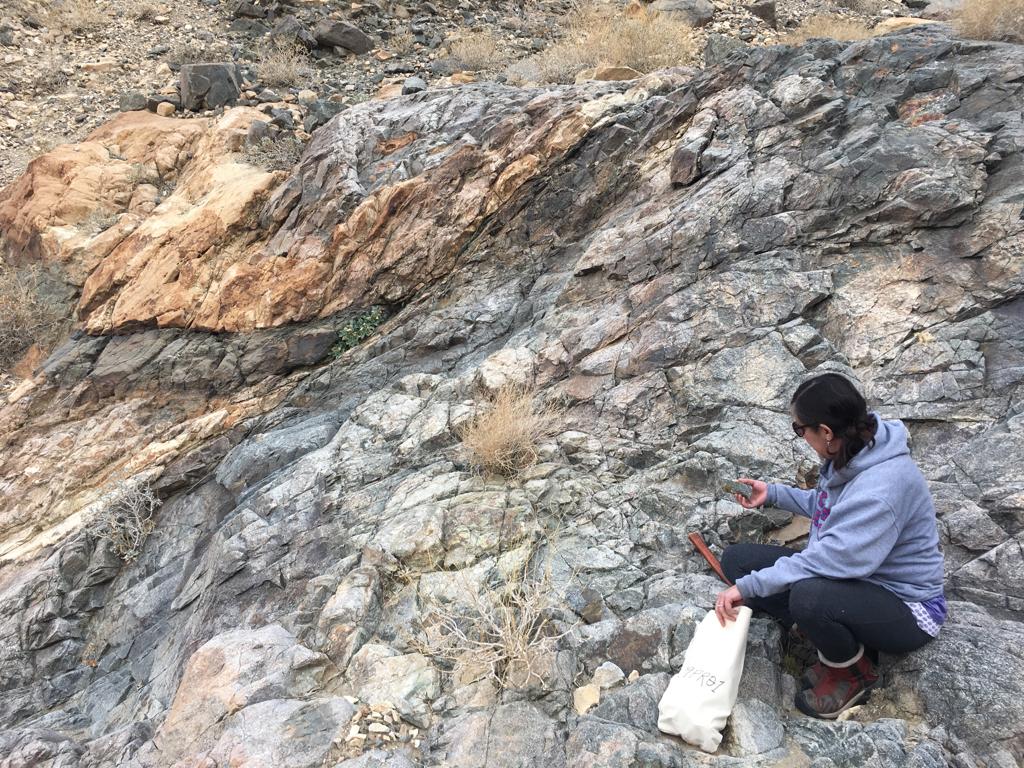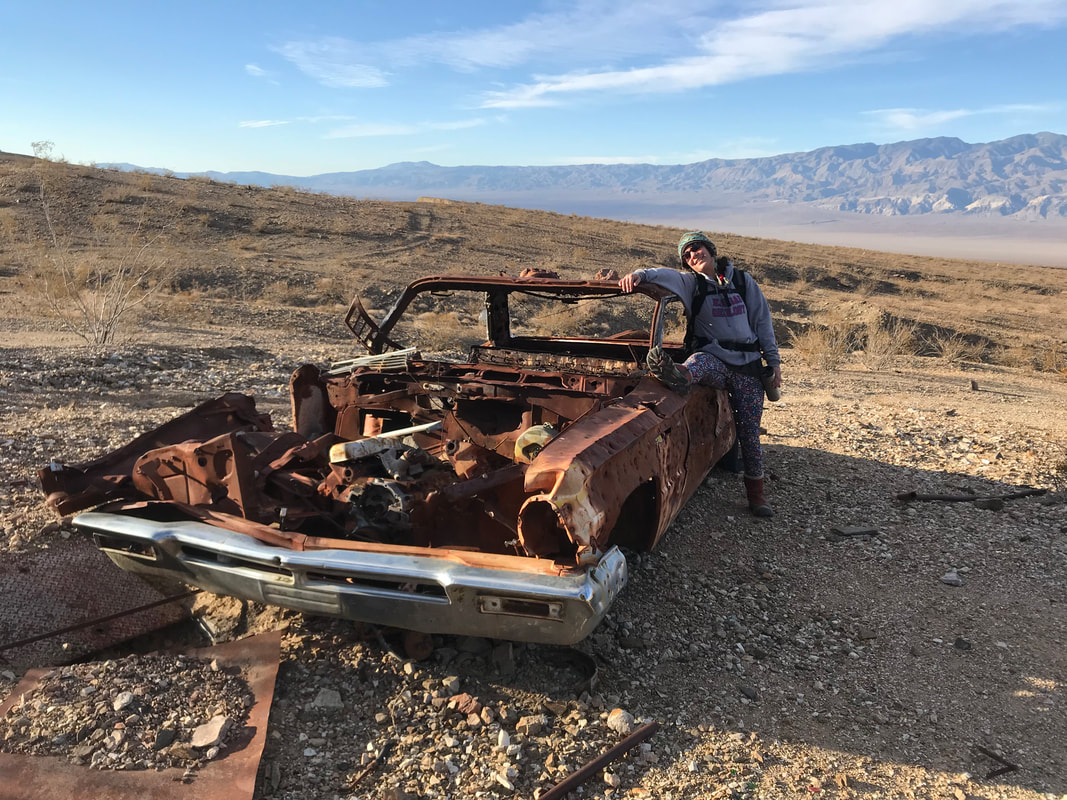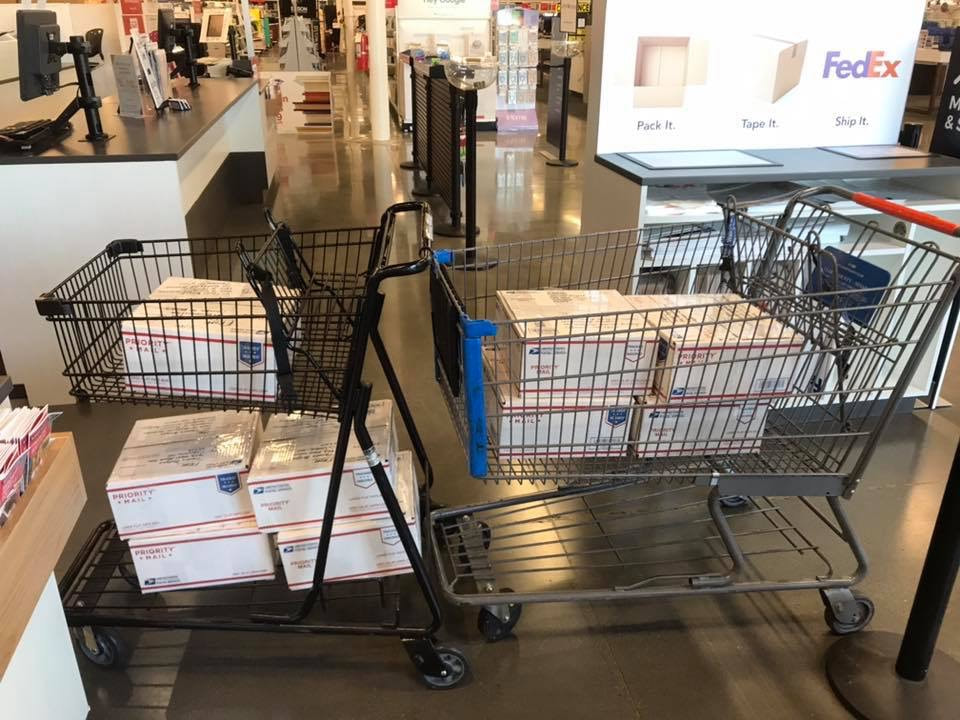July 2022: Summer Fieldwork
This summer was hectic, to say the least. Kim Moore, 3rd year Ph.D. student, and Nathan Reed, 2nd year M.S. student, spent much of the summer in the San Francisco Mountains, west-central Utah, completing a 1:24,000-scale mapping study of the northern part of the range, supported by a grant from the USGS EDMAP program.
In late July (the hottest time of the year!), I headed out to eastern California with Sean Polun, postdoctoral scholar, Taylor Murphy, 1st year M.S. student, and Ryan Owens, incoming MU M.S. student, to collect geochronology samples and photogrammetry data from alluvial fans in the Panamint and Owen's valleys. We survived the 108 deg F weather and rugged topography of the Tuttle fan, west of Lone Pine, CA. The new data will be included in our recently funded NSF study focused on building an age-surface property model for faulted alluvial surfaces in the region.
In late July (the hottest time of the year!), I headed out to eastern California with Sean Polun, postdoctoral scholar, Taylor Murphy, 1st year M.S. student, and Ryan Owens, incoming MU M.S. student, to collect geochronology samples and photogrammetry data from alluvial fans in the Panamint and Owen's valleys. We survived the 108 deg F weather and rugged topography of the Tuttle fan, west of Lone Pine, CA. The new data will be included in our recently funded NSF study focused on building an age-surface property model for faulted alluvial surfaces in the region.
May and June 2022: Congrats to Kenny, Katherine, Nathan and Taylor!
Congratulations are in order to M.S. students, Nathan Reed, Katherine Ludwig, and Taylor Murphy who were awarded student research grants from AAPG (Nathan and Katherine) and GSA (Taylor). These students did an excellent job of preparing their proposals, and the funding will go a long way towards helping them accomplish the goals of their research!
The end of the semester and early summer have also been busy with M.S. thesis defenses and graduations (yay!). In May, Kenny Edge successfully defended his thesis "Examining dissolution procedure effects on trace and rare earth element concentrations and U-Pb ages in conodonts and Katherine Ludwig defended her thesis "Geochronologic and thermochronologic constraints on the Mesozoic to Cenozoic deformation history of southeastern California". In June, Nathan Reed successfully defensed his geologic mapping based thesis "Structural style of the San Francisco Mountains, Sevier fold-thrust belt, Utah". Kudos to all on a job well done!
The end of the semester and early summer have also been busy with M.S. thesis defenses and graduations (yay!). In May, Kenny Edge successfully defended his thesis "Examining dissolution procedure effects on trace and rare earth element concentrations and U-Pb ages in conodonts and Katherine Ludwig defended her thesis "Geochronologic and thermochronologic constraints on the Mesozoic to Cenozoic deformation history of southeastern California". In June, Nathan Reed successfully defensed his geologic mapping based thesis "Structural style of the San Francisco Mountains, Sevier fold-thrust belt, Utah". Kudos to all on a job well done!
April 2022: Two new USGS grants!
Great news: two new projects have been awarded funding from the USGS, one through the Earthquake Hazards Program (EHP) and the other through the Educational Mapping (EDMAP) program. The EDMAP grant will support Nathan Reed, M.S. student, and Kim Moore, Ph.D. student, this summer as they continuing mapping work they started last year on the Frisco thrust in the San Francisco Mountains of west-central Utah. The USGS EHP grant will support a paleoseismic investigation of liquefaction features in central Missouri with the aim of establish the timing and likely source of past earthquakes responsible for ground deformation.
|
Figure captions. (Below) NAIP imagery showing San Francisco Mountains study area relative to nearby ranges. Green dots correspond thermochronology and geochronology samples. (Right) Detailed overhead view (GoogleEarth image acquired in March 1997) depicting irregular light (sand) bodies south of Triplett, MO. Dashed black line depicts the axis of a low-relief ridge in the southern Triplett Terrace surface.
|
February 2022: New JGR Paper!
|
A new month and a new publication! This one is focused on the crustal structure of the western U.S. from passive source tomography. The collaborative study, with researchers from the Michigan State University, links deep geophysical observations with our understanding of the geologic evolution of the Pacific-North American plate boundary.
Please email me for a copy or access it through AGUs website: https://agupubs.onlinelibrary.wiley.com/doi/epdf/10.1029/2021JB022384 |
January 2022: NSF proposal funded!
|
Great news: The NSF proposal I submitted with my Mizzou postdoc., Sean Polun, and colleague, Paco Gomez is being awarded! The project focuses on using machine learning to develop a calibrated remote sensing-based age model for use in slip rate studies. The study corridor spans the Eastern California shear zone (ECSZ) / southern Walker Lane belt, where there are a large number of sites with radiocarbon, luminescence, terrestrial cosmogenic-nuclide, and other age data from published investigations, and there is good remote-sensing data coverage. We hope the effort will yield an internally consistent, calibrated means of estimating surface ages using remotely-sensed data and new slip rates for the eastern Garlock fault.
Figure caption. Map of previously dated surfaces in southeastern California labeled by geochronometer type; ‘mixed’ type includes at least two of the noted methods. Inset area (location indicated by dashed box) shows various faulted features for slip rate analysis. Boundaries of China Lake (CL) Naval Weapons Station and Fort Irwin (FI) in red. Death Valley National Park (DVNP) boundary is green.
|
December 2021: AGU New Orleans, LA
|
Our research group had several presentations at the AGU Fall Meeting in New Orleans, Louisiana, December 13-18. Sean Polun and students, Kim Moore and Qian Zhao, presented their dissertation research. I also had an oral presentation and co-chaired a session with Jonathan Delph (Purdue). The hybrid format of the meeting was challenging and a bit frustrating at times, but I brought my daughter with me to the meeting (she even got her own badge) and we had a good time doing some site seeing in between conference activities.
|
October 2021: GSA Portland, OR
Students Kim Moore, Katherine Ludwig, Nathan Reed (all pictured below), and Qian Zhao (who attended remotely) had poster presentations at the GSA Connects 2021 meeting in Portland Oregon, October 10-13. Everyone did a great job of sharing their science with the GSA community. We also had fun catching up with old friends and our Mizzou alumni.
June 2021: San Francisco Mountains Field Work
Nathan Reed (1st year M.S. student), Qian Zhao (3rd year Ph.D. visiting scholar), and I had a great trip doing reconnaissance field work in the San Francisco Mountains, east-central Utah. We collected bedrock thermochronology samples from the upper plate of the Frisco thrust. Nathan and Kim Moore (2nd year Ph.D. student will be working together over the next year or two to remap the range at 1:24,000 scale. Kim is also working on examining Late Cretaceous to Eocene conglomerates exposed in in the range and the Cricket Mountains, to the north, that may provide insights into the timing of thrusts and normal faults in the region.
April 2021: Southern Death Valley Field Work
Katherine Ludwig (1st year M.S. student) and I had a great trip, driving across the country to get to her field site in the Avawatz Mountains at the southern end of Death Valley. We collected bedrock thermochronology samples that Katherine will use alongside published thermochronology data to establish the exhumation history of the range. We also spent a portion of our trip sampling Miocene strata in the region for detrital zircon U-Pb geochronology. These sediments may provide important clues to a southern extension of the Southern Death Valley fault. Stay tuned for our results!
May 2021: Graduate Research Grant Awards!
Kim Moore (2nd year Ph.D. student) has been awarded a student research grant from the AAPG Grants-in-Aid Program. Shout out to Kim on writing a great proposal and getting this funded on her first shot! Her project is titled: "Time-temperature history and the development and demise of the Sevier hinterland plateau". Additionally, Kim and Nathan Reed (1st year M.S. student) have been awarded funding to support their field work through the StraboSpot program, an NSF sponsored initiative focused on developing new software and tools for digital field mapping and data collection.
July 2020: Begum Kurtoglu Passes Defense!
Congratulations to Begum Kurtoglu for successfully defending her M.S. thesis. She did an outstanding job on her thesis and the defense presentation. We are all so proud and excited for her. Great job!
May 2020: Graduate Research Grant Award!
Kim Moore (1 year Ph.D. student) has been awarded a student research grant from the Geological Society of America. Shout out to Kim on writing a great proposal and getting this funded on her first shot! Her project is titled: "Time-temperature history and the development and demise of the Sevier hinterland plateau".
April 2020: Undergraduate Research Grant Award!
Daniel Shi (B.S. in Geological Sciences) has been awarded student research grant from the North-Central Section of Geological Society of America. Kudos to Daniel on writing an excellent proposal! His senior/honors thesis project is titled: "Detrital zircon provenance constraints on the depositional setting of the Eagle Mountain Formation and implications for reconstructions of Basin and Range extension".
March 2020: Graduate Research Grant Awards!
Begum Kurtoglu (2nd year M.S. student) and Kenny Edge (1st year M.S. student) have been awarded student research grants from the AAPG Foundation, Grants-in-Aid program. Begum's thesis project is titled: "Constraining space-time strain paths of the Panamint and Cottonwood Mountains, California, through low-temperature thermochronology". Kenny's thesis project is titled: "Viability of conodonts as geochronometers". Congratulations to them both on writing terrific proposals!
January 2020:
|
September 2019: GSA Phoenix, AZBegum Kurtoglu, M.S. student, presenting her thesis research at the Geological Society of America annual meeting in Phoenix, AZ in September.
|
January 2019:
|
